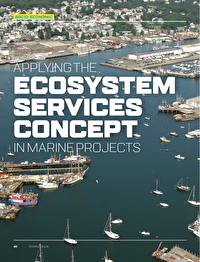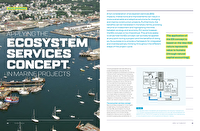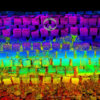The maximum benefit from using ES concepts can be expected when applied from the beginning of a project. However, even if the ES approach is only applied in later phases of the project, it can still provide significant context and insights. As will be described below, the purpose of the ES framing and the chosen approach may change, depending upon the project stage and phase, and the decisions being made.
Project cycle phases require different levels of resolution and detail and, more importantly, address different questions. Within a project cycle, four types of ES assessment (ESA) types can be defined. As can be seen in Figure 3, each of these ESA types informs decisions and bridges different project cycle phases. The key features of each ESA type are described below.
Baseline/scoping ESA carried out during plan development and design, aims to answer questions, such as ‘What are priority ES?’ and ‘What is their current status?’ This bridges the initial concept phase to the conceptual design phase. Any idea for developing a project goes through a very early step (conception of a plan) in which at a quick-scan or reconnaissancelevel decisions need to be made on further development of the plan. In the scoping ESA, a conceptual (i.e. not detailed) description is made of the biophysical environment of the project area and how the plan would interact with this area, illustrating the cause and effect relationships and how these affect ES. This provides an opportunity to think about goals other than the strictly technical project goals that can be achieved. Essential stakeholders should be identified and potential risks and benefits identified. The goal of a project is formulated at this point and discussed with the key stakeholders.
Prospective ESA carried out during the design phase, investigates how ES might be impacted by potential design scenarios. This bridges the conceptual to the technical design phase. Introducing ES during the conceptual design gives the project more freedom to consider ES risks, opportunities and trade-offs when choosing and optimising a design alternative. If ES concepts are introduced in the technical design, the focus will be on what gains can be expected from adapting the design within the already rather fixed technical design specifications. In a Prospective ESA, the extended set of goals (technical goals, ES goals, societal goals) are more quantitatively assessed. This is an assessment based on knowledge of the biophysical state of the project environment, cause and effect relationships between the technical design and the biophysical state, affecting near-field and far-field natural (biotic and abiotic) processes and functions. This results in an overview of trade-offs of ES impacts, their likelihood and extent. A prospective ESA may also consider project vulnerabilities to changing ES provision, due to climate and other changes. This phase should include plans on how to monitor the impacts of the project on the natural (and socio-economic) environment in the context of ES. It should be noted that such a Prospective ESA can be developed even at a relatively low information level, e.g. based on stakeholder interviews or workshops.
Retrospective ESA carried out during and after construction and operation, aims to evaluate whether ES were impacted during the evaluation phase of the project, based upon monitoring data. The reason for doing a retrospective ESA is to learn and adapt. There are two types of Retrospective ESA: one evaluates data in the absence of a prior Prospective ESA (and thus evaluates monitoring data with an ES framing, but with no prior ES predictions), and the other evaluates monitoring results in the context of ES impacts predicted by the Prospective ESA. If ES impacts are determined to be unacceptable (or if objectives change), potential adaptive strategies are considered and an Adaptive ESA may be carried out. In either case, outcomes should be evaluated in interaction with stakeholders. If all goals are reached (and no new ones have been developed) and the retrospective ESA outcome does not call for further adaptation of the project, the ESA for the project stops here, only to be picked up again when the project is decommissioned (if ever).
ES monitoring provides the data to bridge the gap between the Prospective ESA (which predicts impacts of scenarios) and Retrospective ESA (which assesses whether impacts have occurred). ES monitoring is therefore important to provide input for all types of ESA and throughout the project cycle. ES monitoring is not however, an assessment type and hence not included in the four types mentioned above. If undesirable impacts are deduced, adaptive strategies or measures may be considered. Interaction with stakeholders is necessary to evaluate the outcome of the project, and any necessary adaptation. If adaptation is deemed necessary, an Adaptive ESA may be carried out. If all goals are reached (and no new ones have been developed) and the Retrospective ESA outcome does not call for further adaptation of the project, the ESA for the project stops here, only to be picked up again when the project is decommissioned (if ever).
Adaptive ESA evaluates how ES might be affected by adaptive scenarios. Adaptive ESA also uses prospective (rather than retrospective) assessment however, as it is carried out far into the project cycle, benefits from all previous scoping, assessment and data, and is focused in scope. Ideally, at least one round of ESA has taken place and technical and communication lessons have been learned (e.g. Did we address all stakeholders and how well?). Less ideally, nothing (in the context of ESA) has yet been done; in this case, a focused Retrospective ESA may be needed. In all cases, degrees of freedom and potential benefits of an ESA are smaller than in a full Prospective ESA, however the use of ES in considering adaptations to the project can still be beneficial.
The generic approach of the ESA framework (as described in Figure 2) remains constant throughout the project cycle, no matter which ESA type is undertaken. As one moves through the project cycle, more detailed information (if available) is required; information developed in one stage can be built upon in the next. While the first three steps in the framework are more in the focus during the design phase of the project, the last two steps gain importance in the implementation and evaluation phases of a project. The exact ESA approach will also depend not only upon the phase and stage in the project cycle, the role the information plays in a decision-making or communications effort but also upon the socio-environmental situation and the priorities put forward.

































